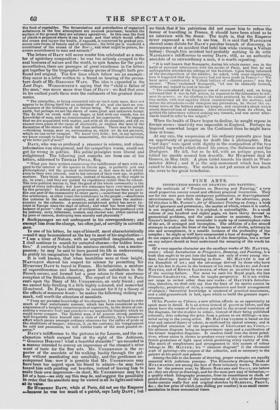FINE ARTS.
INSTRUCTION-BOOKS ON DRAWING AND PAINTING.
Or the multitude of " Treatises on Drawing and Painting," a very small proportion convey sound and efficient practical instruction. They are for the most part mere catchpenny publications, or drawingmasters' advertisements, for which the public, instead of the advertiser, pays. Of this class is Mr. PARSEY'S Art of Miniature Painting on Ivory; a book full of ignorance and pretension ; the matter of which, where it is useful, is not original, and where it is original, is unintelligible. In a small volume of one hundred and eighty pages, we have thirty devoted to geometrical problems, and the same number to anatomy, front Mr, GREEN'S lectures; and the remainder is made up of commonplace rules of the art, ill arranged and incomplete. The addition of a few absurd attempts to analyse the lines of the face by means of circles, arbitraryin size and arrangement, is a notable instance of the profundity of the compiler ; he might as well have compounded a bust of dumplings. We do not expect great scholarship in a book of this description, but a writer on any subject should at least understand the meaning of the words he uses.
Of a very opposite character are the excellent works of Mr. HAYTER, senior ; whose Introduction to Perspective, Drawing, and Painting, is a book that ought to be put into the hands not only of every young stu- dent, but of every person learning to draw. Mr. HATTER is one of the Gamaliels of art ; and the advantage derived by those who have sat at his feet is shown in the instance of his sons, CHARLES and JOHN HATTER, and of EDWIN. LANDSEER, of whom as an artist he was one of the nursing-fathers. Nor must we omit his Royal pupil, the late Princess CHARLOTTE, whom he taught perspective. It is not within our scope to review other than new works : of HATTER'S Introduc- tion, therefore, we shall only say that the least of its merits consist in simplicity, perspicuity of style, a comprehensive and lucid arrangement of subjects : theoretical knowledge is rendered of practical attainment, and a solid groundwork is laid, upon which to build the greatest super. structure.
Of his Treatise on Colours, a new edition affords us an opportunity to
speak more in detail. It is all octavo instead of quarto as before, and the plates have the names of the colours printed in the several interstices of the diagrams, for the student to colour, instead of their being published coloured ; thus reducing the price from a guinea to six shillings—a ma- terial saving to the young artist. Mr. HATTER'S system is based on the true and natural theory of colour, as confirmed by optical science; and is a simplified extension of the proposition of LEONARDO DA VINCI,- his ultimate diagram being an improvement upon and a ramification of the former imperfect diagrams. It resolves itself into the three primi- tives, whose union is shown to produce every variety of colour ; the dif- ferent gradations of light upon which producing every variety of tint. The merit of completeness and arrangement in this system of colour belongs to Mr. HATTER; his " ultimate diagram" is the chromatic scale of painting—the compass of the colourist, and as necessary to the painter as his pencil and palette.
Among the aids to the learner of drawing, proper examples are equally
essential with judicious precepts. The Elementary Drawing Books of H ULLMANDEL are among the best of these initiatory works. The num- bers for the present year, by Messrs. BARNARD and GACCI, are before ps : they are clever as drawings, and for the most part easy of imitation,— a quality which lithography promotes, from its resemblance to chalk or pencil-drawing. Some of the earlier volumes of this series of drawing- books contain really fine and original sketches by HARDING, PROUT, &C. ; the low price of which (one shilling per number) is no small recom- mendation in these economical times.


























 Previous page
Previous page